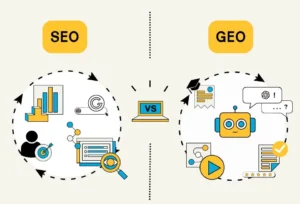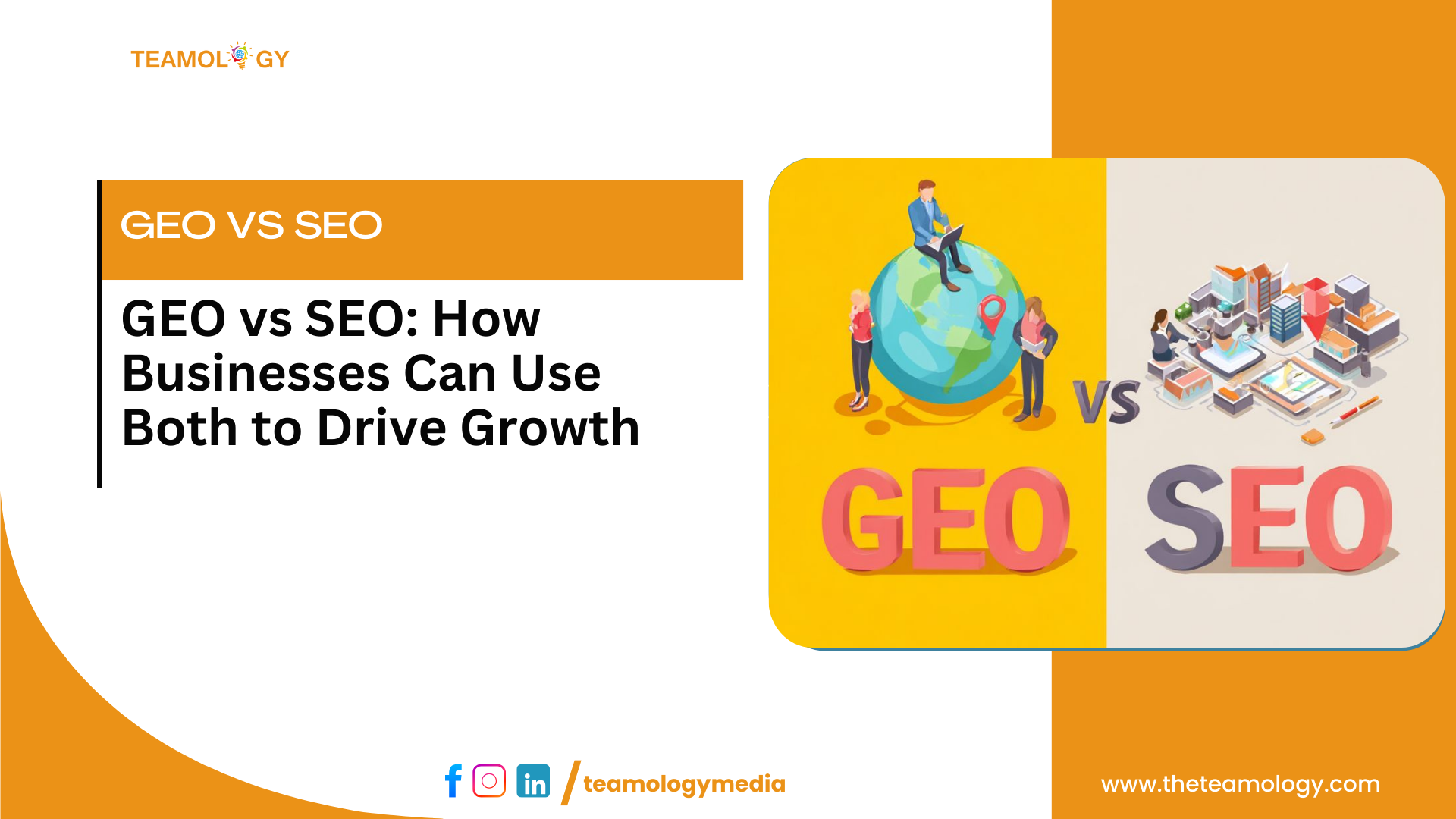With how vast Digital Marketing is, it is no wonder that it has tons of acronyms, maybe more than a medical textbook. Hence, beginners often confuse SEO and GEO. Although they sound similar, they have very different strategies. So, to grow online and understand the difference between GEO and SEO, you must understand them individually and in relation to each other.
What is SEO
SEO (Search Engine Optimisation) is the process of optimising your website to rank better in search engines like Google. The main purpose of SEO is to help people find you online by improving visibility for relevant keywords, building authority, and delivering valuable content.
What is GEO?
In digital marketing, GEO stands for geo-targeting or Geo-optimisation. Unlike SEO, GEO focuses on strategies related to a user’s location, which are tactics used in digital marketing that concentrate on a user’s location. Rather than just targeting keywords, you customise your marketing to target certain cities, neighborhoods, or even regions.
For instance, A hospital in Delhi doesn’t just want to rank for “best cardiologist”. It needs to appear for “best cardiologist in Delhi” for it to be effective and efficient. That is GEO optimization at work.
GEO Optimization Explained
The process of refining your campaigns, advertisements, and content to appeal to people in certain locations is known as geo optimisation.
It may entail:
- Including location-specific keywords (“in Mumbai,” “near me,” etc).
- Limiting the distribution of advertisements to specific regions.
- Building landing pages for various branches or cities.
- Optimising Google My Business listings for local searches.
Difference Between GEO and SEO
- SEO and GEO stand for Search Engine Optimization and Geo-targeting/Geo-optimization, respectively.
- SEO focuses on Keywords, ranking, and organic visibility. And GEO caters towards location, targeting, and local relevance.
- SEO works on a scope range of global, national or local. But GEO’s scope expands only locally or hyper-locally.
- SEO aims to get discovered in search engines. However, GEO captures location-specific customers.
Their scope and aim are where they diverge most. By increasing overall rankings and visibility in search engines, both domestically and internationally, SEO reaches a broad audience. In contrast, GEO makes sure that marketing initiatives are extremely pertinent to the location of the client.
Another difference is the end goal. While the goal of GEO is to attract local or regional clients, the goal of SEO is to make selected keywords discoverable throughout search engines. In short, GEO makes you geographically relevant, whereas SEO makes you visible. SEO creates your Internet presence, and GEO refines it to ensure that you are reaching the appropriate people at the right time.

What is GEO in Digital Marketing?
GEO in digital marketing refers to adjusting your campaigns according to geographic location. This can include geo-optimisation for company websites, geo-targeting in marketing (displaying advertisements solely to city dwellers), or region-specific product personalisation.
For example, an e-commerce company might have distinct promos for the US, UK, and India. Only clients within five kilometres of the coffee shop’s location may be targeted. In digital marketing, that is GEO.
GEO Targeting In Marketing
To present highly relevant advertisements, geo-targeting in marketing employs user location data (by IP addresses, GPS, or Wi-Fi). In our daily lives, we all have searched for “restaurants near me” and instantly seen options nearby. That is Geo-targeting in action. One of the major benefits of GEO targeting is better ROI because the ads reach the right audience. Also, due to local relevance, the conversion rate is higher. The means ad spend is far less wasted.
GEO vs. SEO Strategy
An SEO strategy comprises optimizing blog posts, building backlinks, and targeting keywords for worldwide exposure. However, a GEO strategy focuses on localized advertisements, landing sites tailored to a particular location, and local SEO strategies.
So, it is clear that combining both SEO and GEO typically yields the greatest results.
GEO Optimisation for Business
Geo optimization for business is essential for companies that have branches, physical locations, or region-based services. It guarantees that your marketing budget won’t be wasted on unnecessary advertisements.
Some additional tips:
- Optimize your Google Business Profile. You can add business hours, location, reviews, and services.
- Include local schema markup and city-based keywords.
- Create service pages tailored to a specific region.
- Run PPC advertisements or campaigns targeting customers only within a chosen radius.
SEO vs GEO Marketing Examples
An example of SEO would be a fashion blogger who ranks for “best summer outfits” worldwide.
An example of GEO marketing is a Bangalore boutique that caters exclusively to women in Bangalore who are looking for “summer outfits near me.”
Although they have different functions, both are powerful tools for your online growth and presence. They form a comprehensive online presence when combined.
Conclusion
Search Engine Optimisation, or SEO, is concerned with ranking in search results. And GEO or Geo-targeting/Geo-optimization concentrates on targeting depending on location. In a nutshell, to get visibility everywhere, use SEO, and to attract the appropriate clients in the ideal location, use GEO.


